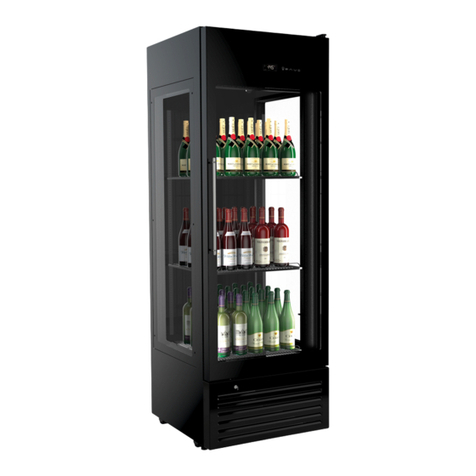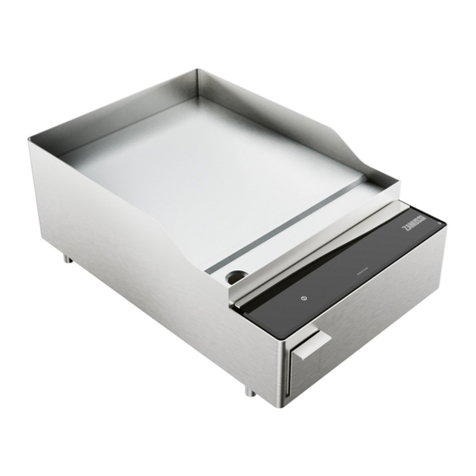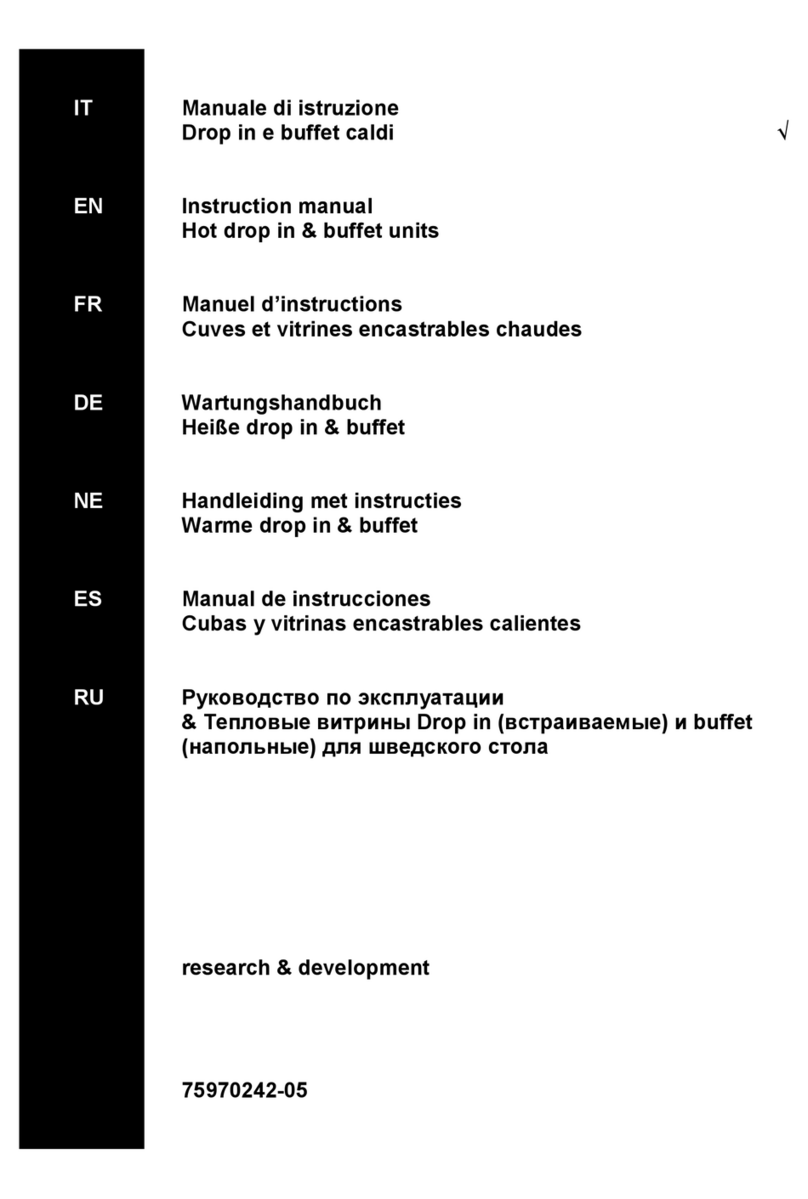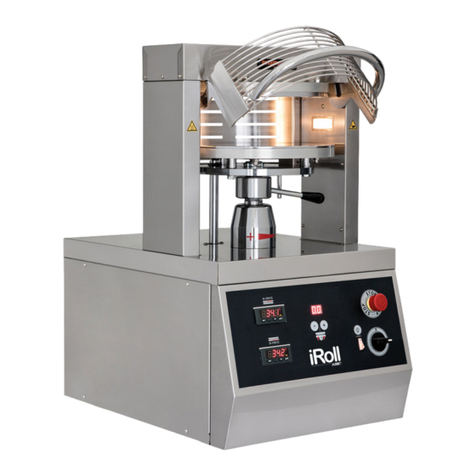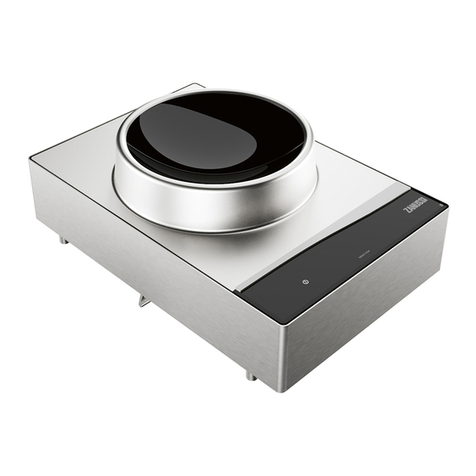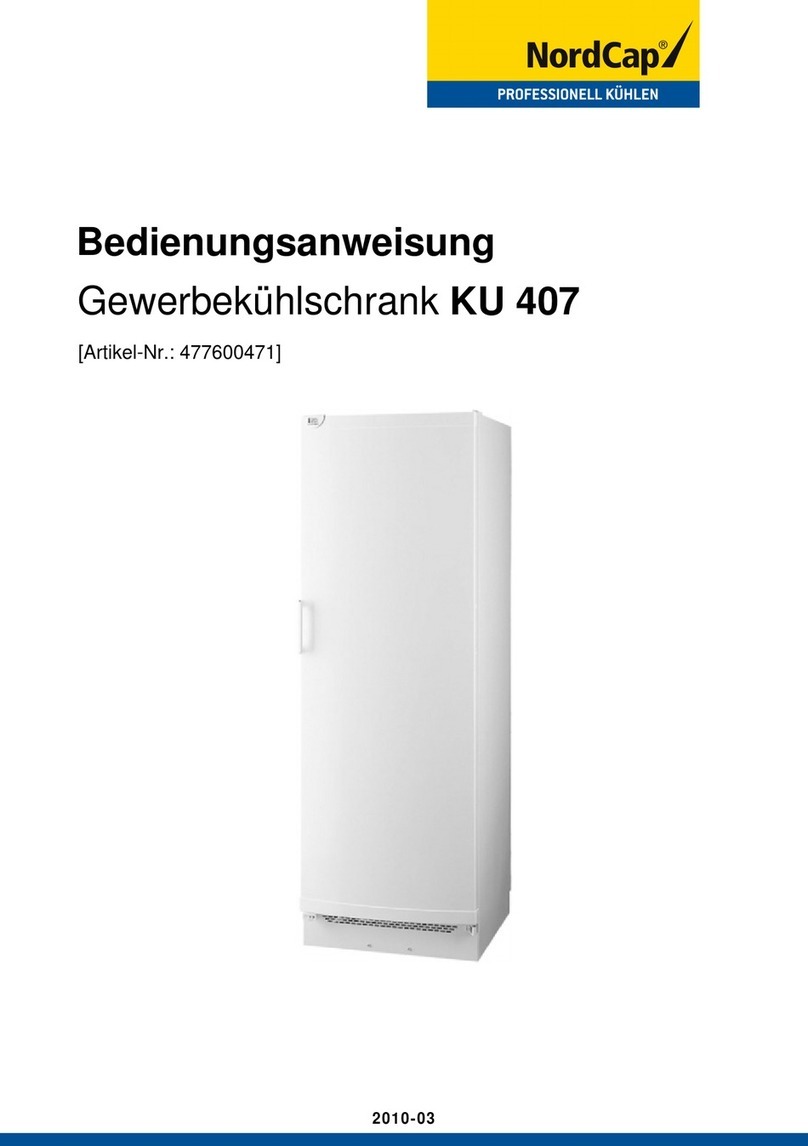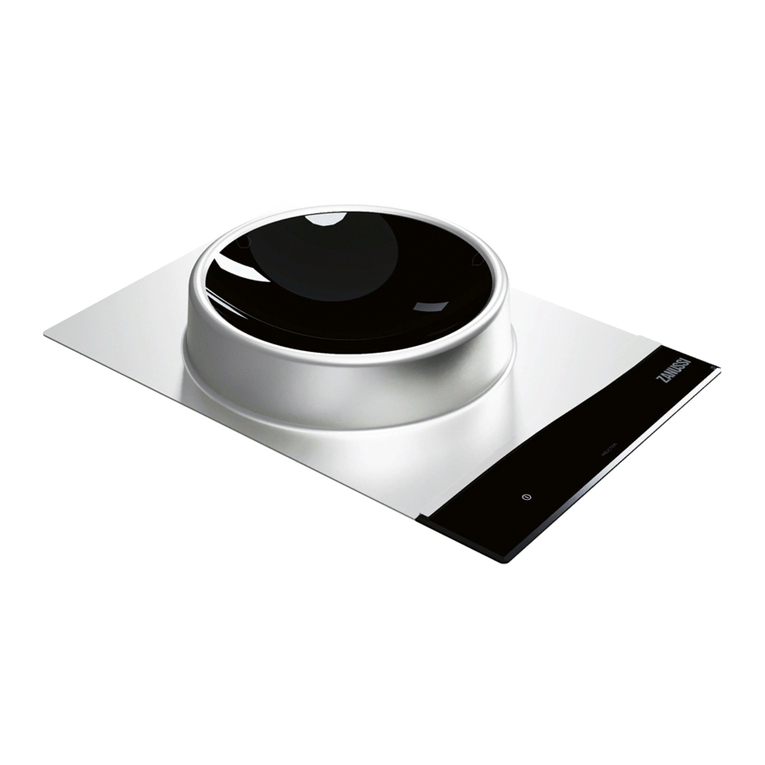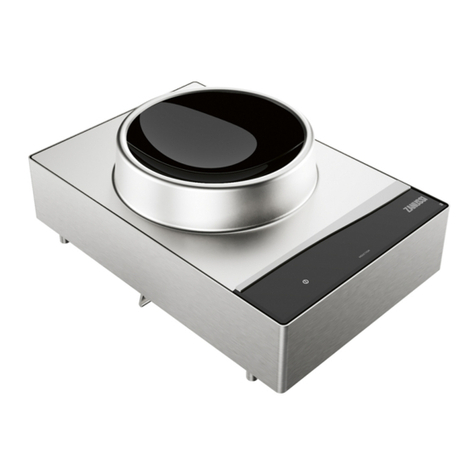
DE/6
i) Unterbrechen Sie die Stromversorgung der Kammer mit der
Starttaste (Abb. 27 und 28 Abs. 7): eine rote LED oben rechts
erlischt.
j) Der Ofen wird mit Hilfe des Hauptschalters (Abb. 27, 28
Detail 9) ausgeschalten.
Beim Wiedereinschalten des Ofens erscheinen die Werte, die
beim Ausschalten gültig waren
ANMERKUNG:
Um die Lebensdauer zu
verlängern wird empfohlen, das Gerät nur kurzzeitig auf
hohe Temperaturen zu setzen. Die vorgesehenen
Höchsttemperaturen dürfen nur zur Reinigung durch
Hochtemperaturreduzierung von Rückständen im
Innenraum verwendet werden.
3.2.3 ERSTE INBETRIEBNAHME
Beim ersten Einschalten des Geräts sowie beim Einschalten nach
einer längeren Nichtbenutzung muss das folgende Heizverfahren
beachtet werden:
- Die Temperaturen auf 90°C einstellen und die Kammer ca. 2
Stunden in Betrieb lassen. Falls sich sehr viel Dampf im Inneren
der Kammer befindet, die Tür für einige Minuten öffnen, den
Dampf austreten lassen und dann wieder schließen.
- Die Temperaturen auf 150°C anheben und die Kammer ca. 2
Stunden in Betrieb lassen. Falls sich sehr viel Dampf im Inneren
der Kammer befindet, die Tür für einige Minuten öffnen, den
Dampf austreten lassen und dann wieder schließen.
- Die Temperaturen auf 200°C anheben und die Kammer ca. 2
Stunden in Betrieb lassen. Falls sich sehr viel Dampf im Inneren
der Kammer befindet, die Tür für einige Minuten öffnen, den
Dampf austreten lassen und dann wieder schließen.
- Die Temperaturen auf 220°C anheben und die Kammer ca. 1
Stunde in Betrieb lassen. Falls sich sehr viel Dampf im Inneren
der Kammer befindet, die Tür für einige Minuten öffnen, den
Dampf austreten lassen und dann wieder schließen.
- Die Temperaturen auf 380°C anheben und die Kammer ca. 1
Stunde in Betrieb lassen. Falls sich sehr viel Dampf im Inneren
der Kammer befindet, die Tür für einige Minuten öffnen, den
Dampf austreten lassen und dann wieder schließen.
- Vor dem nachfolgenden Einschalten warten, bis die Temperatur
auf Raumtemperatur sinkt. Falls sich sehr viel Dampf im
Inneren der Kammer befindet, die Tür für einige Minuten
öffnen, den Dampf austreten lassen und dann wieder schließen.
Dieses Verfahren gestattet es, die Feuchtigkeit aus dem Ofen
abzulassen, die sich während der Produktion, der Lagerung oder
des Versands im Ofen angesammelt hat.
ANMERKUNG:
Während der vorgenannten
Operationen könnten unangenehme Gerüche auftreten. Den
Raum gut lüften.
ACHTUNG!
Die Tür nicht für längere Zeit öffnen,
vor allem bei hohen Temperaturen, um gefährliche
Verbrennungen und Überhitzungen von Komponenten in der
Nähe der Tür zu vermeiden.
ACHTUNG!
Der Ofen kann erst für das erste Backen
verwendet werden, wenn die vorgenannten Operationen
ausgeführt worden sind, die für einen ordnungsgemäßen
Betrieb absolut unverzichtbar sind.
ACHTUNG!
Führen Sie nie Backvorgänge beim
ersten Einschalten oder beim Einschalten nach längerer
Nichtbenutzung aus.
ANMERKUNG:
Bei dem nächsten Einschalten, zu
schnelle Heizphasen vermeiden, um die Lebensdauer der
Komponenten (feuerfeste Platte...) zu verlängern. Vor
Erreichen des Back-Set Points muss jedes Mal mindestens 40
Minuten eine Temperatur zwischen 120°C und 160°C
eingehalten werden.
3.3 INBETRIEBNAHME DES GÄRSCHRANKS
Auf dem rechten vorderen Ständer des Gärschranks befindet sich
das Bedienfeld (siehe Abb. 17).
1. Kontrolllampe (ON/OFF)
2. Ein-/Ausschalter für die Innenbeleuchtung (light).
3. Thermostat zum Einschalten und Regulieren.
a) Den Gärschrank durch Drehen des Thermostates einschalten
(Abb. 17 Teil 3). Die Leuchtdiode schaltet sich ein (Abb. 17
Teil 1).
b) Die gewünschte Temperatur bis maximal 65°C einstellen.
c) Zur Abschaltung des Gärschrankes den Thermostat auf 0
(null) drehen (Abb. 17 Teil 3).
d) Ein-/Ausschalter für die Innenbeleuchtung des Gärschranks
mit eingebauter Led.
ACHTUNG!
Die Widerstände nicht berühren, da
Verbrennungsgefahr besteht.
3.5 ABSTELLEN
Die Hauptschalter des Ofens (Abb. 16 A B Teil 7 und 14 und Abb.
27-28 Teil 7/9) und die der Gärschränke (Abb. 17 Teil.3 und Abb.
23 Teil.4) ausschalten und von eventueller Haube mit
Dunstabzugsmotor. Den Ofen und die Gärschränke stromlos
setzen, indem die außenseitigen Hauptschalter betätigt werden.
4 WARTUNG
4.1 EINLEITENDE SCHUTZMASSNAHMEN
ACHTUNG!
Bevor Wartungsarbeiten am Gerät
durchgeführt werden, muss man die Stromzufuhr
unterbrechen, indem die Schalter auf der Außenseite des
Ofens und/oder der Hefeteigzelle ausgeschalten werden und
warten Sie, dass die Raumtemperatur absinkt. Verwenden Sie
immer geeignete Schutzvorrichtungen (Handschuhe, Brillen
usw).
Alle Schutzmassnahmen sind entscheidend für die Erhaltung
der Funktionstüchtigkeit des Ofens und eine Nichtbeachtung
kann schwere Schäden verursachen, die nicht unter die
Garantieleistungen fallen.
4.2 ORDENTLICHE REINIGUNG
Nachdem die unter Punkt 4.1 beschriebenen Operationen
durchgeführt wurden, für die ordentliche Reinigung wie folgt
vorgehen:
Täglich nach Arbeitsende und bei abgekühltem Gerät sorgfältig
eventuelle Produktreste, die während des Backens entstehen
können, von allen Teilen entfernen. Dazu einen feuchten Lappen
oder Schwamm und Seifenwasser benutzen, nachspülen und
trocknen, und bei den satinierten Bauteilen die Richtung der
Satinierung beachten.
Alle zugängliche Komponenten in geeigneter Weise reinigen.
ACHTUNG!
Entfernen Sie das eventuelle beim
Backen ausgetreten fett täglich, da es zu Verbrennungen und
Verpuffungen führen kann.
ACHTUNG!
Waschen Sie das Gerät nicht mit
Wasserdüsen oder Dampfreinigern. Darauf achten, dass das
Wasser oder eventuell verwendete Reinigungsmittel nicht mit
den Elektroteilen in Berührung kommen.
Die Reinigung des Geräts mit gesundheitsschädlichen
Reinigungsmitteln ist verboten.
ANMERKUNG:
Die gehärteten Scheiben der
Türen erst reinigen, wenn sie nicht mehr heiß sind.
Keine Lösemittel, Reinigungsmittel mit chlorierten oder
schleifenden Substanzen, sowie Werkzeuge verwenden, die
die Oberflächen beschädigen können. Bevor das Gerät wieder
eingeschaltet wird, kontrollieren, ob keine bei der Reinigung
verwendeten Gegenstände in den Kammern liegen geblieben
sind.
4.3 LÄNGERER NICHTGEBRAUCH
Wenn das Gerät für längere Zeit nicht benutzt wird:
- Das Gerät von der Stromversorgung trennen.
- Das Gerät abdecken, um es vor Staub zu schützen.
- Die Räume regelmäßig lüften.
- Das Gerät vor dem erneuten Gebrauch reinigen.


